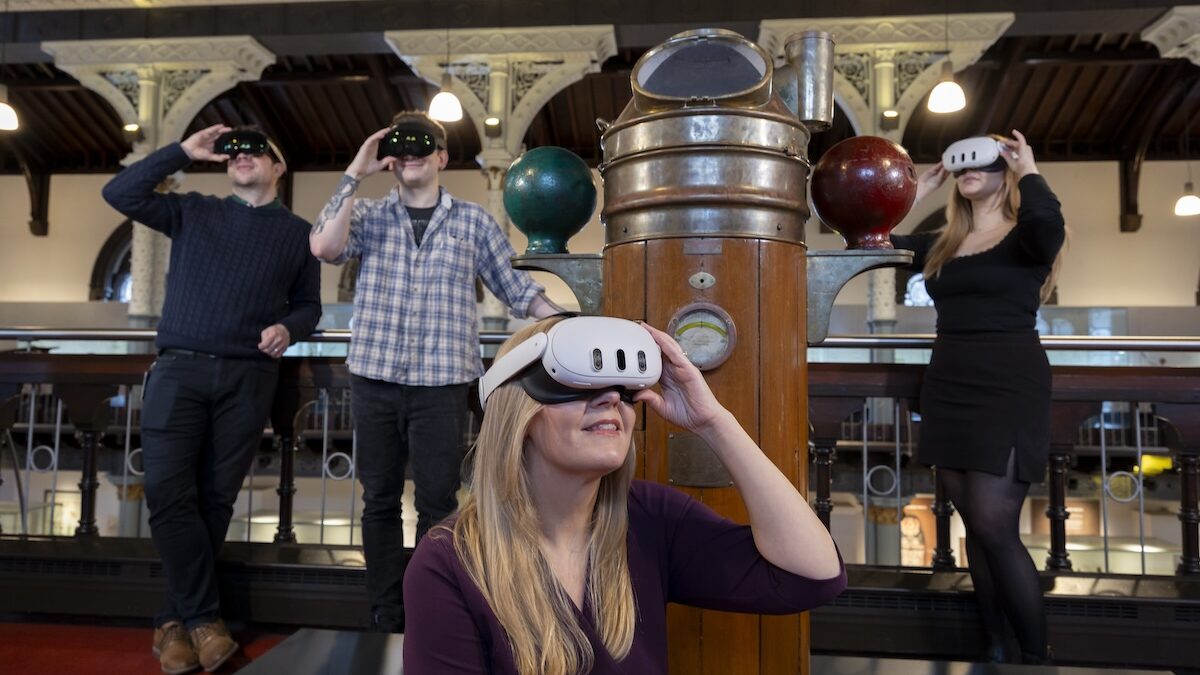A virtual museum dedicated to electricity pioneer Lord Kelvin has been unveiled by the University of Glasgow to mark the bicentenary of his birth.
The online experience is the latest development in the £5.6 million ‘Museums in the Metaverse’ project, which is digitising assets from cultural collections around the world to make them available in virtual form.
The virtual exhibition features a series of carefully-digitised scientific instruments and artifacts related to Kelvin’s work at the University of Glasgow, many of which are not normally on public display.
They are displayed in a digital recreation of a typical 19th century University of Glasgow laboratory, built from historic photos of Kelvin’s labs and featuring historically accurate architectural elements from the Gilbert Scott building.
The space is illuminated by the glow of early electric lighting, highlighting Kelvin’s role as a pioneer of electricity – his house on the University campus was one of the first in the world to be lit entirely by electric bulbs.
Professor Neil McDonnell, of the University of Glasgow’s School of Humanities, is principal investigator of the Museums in the Metaverse project. The Kelvin exhibit was curated by Museums in the Metaverse team members Dr Pauline Mackay, Dr Lynn Verschuren and Dr Alan Matthews in partnership with Lateral North, who created the digital environment.
Dr Mackay said: “We’re delighted to be part of the University’s bicentenary celebrations of the birth of Lord Kelvin, and to work with our colleagues at The Hunterian to put some of their lesser-seen items on virtual display.
“Since the project began last year, we’ve digitised hundreds of objects from collections around the world and will make them available for people to build their own virtual museum collections online from spring next year. This virtual exhibition is the first themed museum we’ve built from the ground up to showcase a single collection, and we’re very proud of the work we’ve put in to create a 19th-century lab environment which showcases Kelvin’s life, work and legacy.
“It really does feel like visitors are transported back in time to see for themselves objects once handled by Lord Kelvin or developed through his research, and it’s a tremendous showcase for the power of virtual reality.”
Born in Belfast on June 26, 1824, as William Thomson, Lord Kelvin became one of the 19th century’s most accomplished scientists. He made breakthrough contributions to physics, engineering and mathematics during his career at the University of Glasgow, where he first enrolled as a student aged just 10.
Announced to coincide with the anniversary of Kelvin’s death on 17 December 1907, the virtual exhibition showcases items from the unique collection of The Hunterian, the oldest public museum in Scotland.
The Hunterian curates a large collection of objects related to Lord Kelvin, some of which are on display in the real-world museum on the University’s campus.
The Museums in the Metaverse content creation team – Conor Fraser, Ben Morris and Christopher Viney – used state-of-the-art photogrammetry techniques to create 3D models that visitors can pick up and examine in virtual space. The team’s high-resolution scans have captured the items with remarkable detail, allowing visitors to see oxidation patterns and material textures in each piece and magnify details for closer inspection.
Highlights of the virtual collection include sections of submarine telegraph cable from the era of the first transatlantic communications, showcasing Kelvin’s key role in the development and laying of the world’s first transatlantic telegraph cable. Visitors can also see two versions of the mirror galvanometer, which was developed by Kelvin to help carry telegraph signals across long-distance cables.
Kelvin’s contributions to electricity are represented with three different types of voltmeters showing the evolution of electrical measurement. The exhibition also features models demonstrating Kelvin’s groundbreaking pitch-based experiments, which showed how substances could exhibit properties of both solids and liquids.
The Geoprecessional Top, a modified globe Kelvin used in class demonstrations to show how the Earth’s axis creates a continuous ‘wobble’ that completes one circuit every 26,000 years, highlights Kelvin’s achievements as an educator. Visitors can also examine Kelvin’s binnacle compass bowl and card, demonstrating his innovations in maritime navigation.




